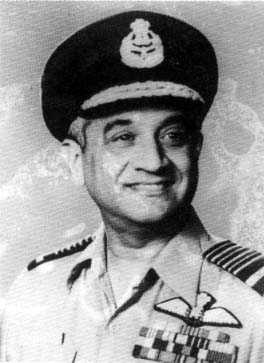An inspiring officer (1923-2018)
AIR Chief Marshal Latif was born on 9 June 1923, and was educated at Nizam College, Hyderabad. His father was Chief Engineer of Hyderabad State, and became Principal of Osmania Engineering College after retirement. While studying at the Nizam’s College, Idris Latif applied for a career in the Air Force and was sent to the Madras Flying Club. He then went to Lahore and on to Begumpet, where he was awarded the trophy for the best simulated force landing. He completed his training at Ambala and was commissioned into the Air Force on 26 June 1942. He was posted to No. 2 Coastal Flight at Karachi, where he flew vintage aircrafts like Wapiti and Harts on anti-submarine missions. His bag containing his pistol was stolen during a train journey, and he was awarded severe reprimand and a penalty of ₹35!
He was next sent to the United Kingdom (UK) for training on Hurricane and Spitfire fighters. On return to India, he was posted to the Hurricane Squadron. He took part in the Burma (now Myanmar) campaign on interdiction duties against ground targets. After a brief tenure in Madras, he joined the No. 9 Squadron equipped with Spitfires. Asghar Khan and Noor Khan who rose to Air Chief’s post in Pakistan, were his colleagues. They tried in vain to persuade Latif to opt for Pakistan.
At the turn of Independence, he was promoted squadron leader at the age of 26, and commanded No. 4 Squadron, equipped with the Tempest fighter aircraft. He was a member of an Advisory Group which went to Indonesia to help them induct jet fighters. A graduate of the Defence Services Staff College and alumni of the National Defence College, he was posted as Air Attache to USA, and was also accredited to Canada. Air Marshal Arjan Singh asked him to continue in that appointment for another term after he completed the usual tenure of three years. Latif returned from the USA in 1965, and held staff appointments in the Eastern Command.
Soon after 1966, he took over the duties of Station Commander of Lohegaon Airport at Pune. The station had the unique distinction of having fighters, bombers, four-engine transport aircraft and World War 2 vintage Liberator aircraft.
He flew in all of them from time to time. His next assignment was in the newly created post of Assistant Chief of Air Staff (Plans) in the rank of Air Vice-Marshal (AVM). He was responsible for the modernisation plans of the Air Force. He was awarded the PVSM in 1971. In the Indo-Pak War of 1971, he visited the forward units to obtain information on the requirements of the units and their performance. He was promoted Air Marshal in 1974, and worked as Air Officer in-Charge, Administration, at Air HQ and later as AOC-in-C Central Command at Lucknow. He organised the relief operations by the Air Force during the floods in Patna in 1975. The operation demanded precision, accuracy and high skills of flying. The next move was to the Air HQ as the Vice-Chief of Air Staff till 1 September 1978, when he took over as the Chief of Air Staff (CAS).
He succeeded in convincing the government to procure Jaguar fighter aircrafts, the proposal for which had been pending for eight years. He also negotiated for the induction of MIG-23 and MIG-25 fighters from USSR. During a visit to France in 1981, he had the opportunity to fly the Mirage-2000 as well. He had a passion for flying and took every opportunity to fly till the end of his service in the Air Force. Just before his retirement in 1981, he flew in the MIG-25 which had been assembled from a semi-knocked out condition.
He retired in 1981, and was appointed as member of the Public Enterprises Selection Board. He held the posts of Governor, Maharashtra, and later, Ambassador to France. He left France in 1988 and settled down in his home town, Hyderabad. He had been ailing for some time, and passed away on 30 April 2018.

